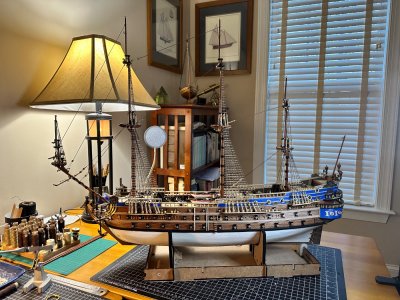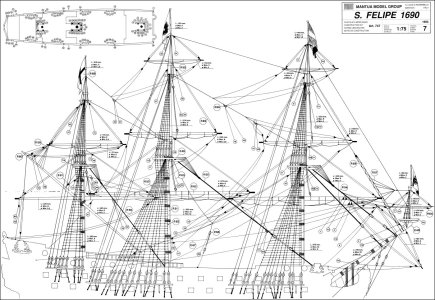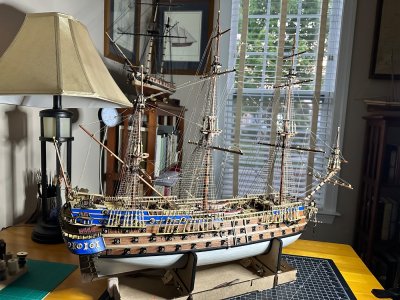- Joined
- Oct 17, 2020
- Messages
- 1,687
- Points
- 488

Hi Maks, no Kit nothing.FrankHi Maks, I ask : you do not have drawings out of Kit.Frank
 |
As a way to introduce our brass coins to the community, we will raffle off a free coin during the month of August. Follow link ABOVE for instructions for entering. |
 |

Hi Maks, no Kit nothing.FrankHi Maks, I ask : you do not have drawings out of Kit.Frank
The OcCre Victory (an unexpected gift from my wife) is to be my next project so even while frustrated, I’m glad to have the San Felipe to practice on. I’ve already purchased the recommended Victory reference books because it’s a certainty that I’m going to need them. I’ll be following your journey with inter
WOW . That is a very nice place for building.Unfortunately, I had packed up the workshop and put the house on the market for sale. But the market is so soft right it homes are simply not selling. So over the next month or so, I’ll bring my shop back from storage, unpack and get things set-up again. Having never built a PoF frame before, I am going to build the USS Constitution cut-way from Model Expo first, and then hopefully start on the Victory this fall. I need to build some basic skills on ships before I tackle the Victory. This was my shop before I packed up, that is a WACO Biplane frame on the worktable, the wingspan will be 109” when complete. I am coming over from the stick built RC world.
View attachment 500522
The Endeavour is a beautiful ship, it was my first wood build and I took 11 months to complete. the plans were sketchy as said, but, YouTube University and some tips from the guys here helped me thru it as I had no idea what I was doing coming from plastic builds. I'm currently finishing up the HMS Diana which has been a nightmare as all that could go wrong, did! and the rigging plans I may as well have thrown them out. Many parts missing and some not enough of. But, again, the forum got me thru it. The Flying Dutchman is my next build and I will probably invest in one of the rigging books. Have fun on the Endeavour.I am in the process of building the Endeavour from OccRe and in agreement with all those modellers who are building ships from OcCre the rigging plans are, to say the least, challenging. The company did some fine work on the hull and deck furniture, including the masts, but seem to have lost interest in the rigging. I am frustrated with the rigging plans and reverted to Marquardt's book "The anatomy of the ship" and to Petersson's "Rigging period ship models" for better details.
I found when rigging is to work from the inside to the outside of the ship, otherwise it becomes fiddly when attempting to tie some of the running rigging in place when all the standing rigging is applied. I suppose it's a matter of choice. I will display the ship without sails.




Congratulations, a beautiful modelHELP! I’ve finished the hull and stepped the masts (OcCre 1/87 San Felipe 1690) and was looking ahead at the rigging plans. The standing rigging I can figure out, but the ‘plans’ for the running rigging have no identifications as to which mast is being referred to. I’ve always heard that OcCre is pretty casual when it comes to rigging instructions but what is provided is borderline ridiculous. Does anyone know what parts are being referred to on the plans labeled E,G, and H? Are they Fore, Main, Mizzen or simply showing one ‘typical’ mast rigging scheme for main, top, topgallant? I’ve messaged OcCre but their customer service is on par with their rigging instructions so I’m not too optimistic. I’m not accomplished enough to free lance it and I’ve already attached all the blocks to all the yards per OcCre’s diagrams so I’m not sure things would line up if I used a generic or ‘typical’ rigging plan. Suggestions?
View attachment 500228
Did you try reaching OcCre for suggestion on ideas. I am sure we could help if you still need it. Please let me know how we can help you.HELP! I’ve finished the hull and stepped the masts (OcCre 1/87 San Felipe 1690) and was looking ahead at the rigging plans. The standing rigging I can figure out, but the ‘plans’ for the running rigging have no identifications as to which mast is being referred to. I’ve always heard that OcCre is pretty casual when it comes to rigging instructions but what is provided is borderline ridiculous. Does anyone know what parts are being referred to on the plans labeled E,G, and H? Are they Fore, Main, Mizzen or simply showing one ‘typical’ mast rigging scheme for main, top, topgallant? I’ve messaged OcCre but their customer service is on par with their rigging instructions so I’m not too optimistic. I’m not accomplished enough to free lance it and I’ve already attached all the blocks to all the yards per OcCre’s diagrams so I’m not sure things would line up if I used a generic or ‘typical’ rigging plan. Suggestions?
View attachment 500228

OcCre appears to take great pains to help the builder through the process of constructing their kits. The pictorial instructions, inclusion of forms and jigs, the excellent ‘Paso a Paso’ YouTube series (for the moment I’ll gloss over the rather consistent and annoying habit of switching focus and introducing new kit series before the older series are properly completed) all seem to show a passion for helping the builder, especially those of us who are newer to the hobby. EXCEPT when it comes to rigging. After spending a year meticulously working on the ship through 40+ pages of photos and 40+ videos, the final crowning step of rigging and sails concludes with a couple of line drawings, a lot of numbers, and virtually no identification of what you’re supposed to be looking at. It’s difficult for me to understand why nobody at OcCre seems to really care about communicating this part of the build with the same thoughtfulness that they have in leading up to this very important end.
OcCre has a reputation of being build friendly. To most of the ‘old salts’ on this forum I’m sure OcCre’s subtle lack of consistent scale, the glossing over of detail, the commonality of parts across kits, and the build simplification process, cause them to choose other kit makers, or they have the amazing and enviable ability to scratch build or heavily modify their own masterpieces. I have learned so much from following the many build logs and am exceedingly grateful of how helpful the members are in answering newbie questions and guiding us through our frustrations, they’ve all been there, done that. For me, coming to the hobby at 74, OcCre has met me where I am, and has given me the opportunity to create something that amazes my friends and astounds my enemies, and is providing hours of personal enjoyment in my retirement. I just wish they’d take a similar approach to the rigging. Newbies are rule followers, yeah, we’ve bought the books but are only just learning to take those first few hesitant steps out into the deeper ends of the kit building pool.
Now that I’ve got that off my chest….I’m figuring it out as I go and muddling through. I now realize that OcCre’s rigging follows a similar pattern across kits just like their build processes and that it’s fairly standard and generic. For my level of expertise, it will do. Perhaps on the next one I’ll try my hand at making a mouse, or learn how to properly seize a block, or add open heart blocks where they should be, and most importantly, buy Ropes of Scale. But for now, I’m like the dancing dog, I’m just damn appreciative of being able to do something I’ve wanted to do for 50 years and do it at all. And as everyone continually says, only I know how bad it is. View attachment 514054



 What a great job
What a great job



